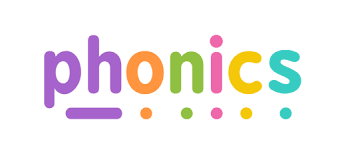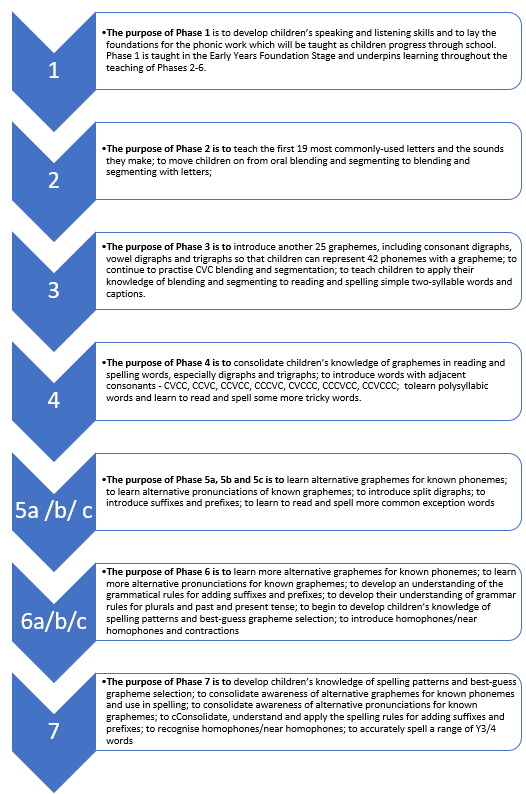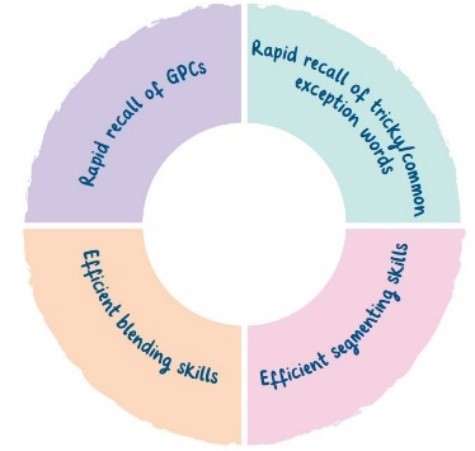
Intent: Phonics – Why does our phonics curriculum look like this?
At Barley Fields we recognise that early phonics teaching can prime children’s minds to learn to read and that daily systematic phonics instruction leads to a quicker start in early reading and spelling. We aim to teach children to read using a range of strategies and approaches which evolve as our children progress through school. At Barley Fields we have a progressive systematic synthetic phonics programme so that all children have well-developed phonemic awareness skills to be successful readers.
Phonics is a way of teaching children how to read and write, it helps children hear, identify and use different sounds that distinguish one word from another in the English language. Written language can be compared to a code, so knowing the sounds of individual letters and how those letters sound when they’re combined will help children decode words as they read. Understanding phonics will also help children know which letters to use when they are writing words. Within our programme children are taught to hear and discriminate sounds in words, to fluently segment and blend sounds for reading and spelling and to learn the many variations in the written code.
We have designed a phonic curriculum which is based on progressive expectations and stages and whose content has been enhanced and supported with resources from a range of Dfe approved phonics providers. Our phonics curriculum is highly structured and teaching materials and resources have been carefully selected and sequenced inline with our learning expectations, teaching pedagogy and curriculum content. Within our teaching we have clear time scales, end points, effective intervention and assessment practices in place to facilitate quality first teaching.
Implementation
Our Phonics curriculum has been designed to develop our children as independent and confident readers who read fluently and with pleasure and understanding. Our children follow a carefully structured, progressive phonics curriculum based on resources from the Floppy’s Phonics reading scheme published by Oxford Reading Tree; a progressive and a range of decodable phonics reading scheme by Smart Kids, My Letters and Sounds by Schofield and Sims and resources from Twinkl Phonics. The implementation of our phonics curriculum is also supplemented with teaching materials from the interactive website Phonics Play. All of these providers are Dfe validated.

In Early Years Phonics teaching is a central part of our reading curriculum and in this key stage children work predominantly on Phases 1-4. From entry to nursery children engage in a range of practical and hands-on activities which progressively develop their skills in the 7 aspects of a Phase 1 phonics programme. In reception, children are taught to hear phonemes in a range of positions; to recognise and write individual graphemes and to begin to blend sounds together to read and to segment sounds to spell. In reception classes phonics is taught daily using a teaching model of revisit, teach, practice and apply to progressively introduce sounds. Clear end points are identified, effective assessment informs teaching and targeted intervention is used to ensure all children make progress. Children’s reading materials and book band expectations are closely matched to the phonics phases being taught.
In Key Stage 1 phonics teaching continues to form an integral part of the wider reading curriculum. In Year 1 it is taught daily and children initially consolidate and learn skills linked to Phases 3 and 4. In Year 1 children consolidate their understanding of alternative phonemes in three progressive stages of 5a, 5b and 5c. Teaching in this Key Stage is multisensory and follows the revisit, teach, practice and apply model to progressively introduce sounds. Clear end points are identified and ongoing assessment informs teaching provision. Effective intervention is used to maintain progress for all children. Children in Year 1 complete the statutory phonics screening check in Summer Term.
In Year 2, our teaching is extended into the Phase 6 units where children enhance their phonics skills for reading by learning to read words with alternative pronunciations, suffixes, prefixes, contractions and homophones. They begin to apply this knowledge in their independent spelling. Each classroom is resourced with phonically decodable texts to ensure reading materials are matched to phonic ability and this curriculum is aligned with expectations in the Year 2 and Year 3 Spelling curriculum. Children who do not pass the Phonics Screening Check in Year 1, receive continued targeted support and small group intervention matched to their phonic attainment phases. These children resit the screening check at the end of Year 2.
In Key Stage 2 we continue to offer intervention and support to children who are working below the age-related expectations in phonics. If, through assessment and observation, teachers have decided that a child needs further phonics intervention, Twinkl Codebreakers or Schofield and Sims support schemes will be used. These are comprehensive and scripted intervention programmes, specifically designed for KS2 pupils to close the gap and develop essential reading and writing skills. Consideration will also be given as to whether these children would be best supported through a Support Plan (see SEND Policy).
In Year 3 we have expanded the skills and knowledge taught in Phase 6 to extend our program to include a Phase 7 level. Phase 7 ensures that in Year 3 children consolidate their understanding of alternative pronunciations, suffixes, prefixes, contractions and homophones within a spelling context. This matches the Year 3 spelling curriculum and ensures children consolidate their skills in the application and use of phonics for spelling.

Pedagogy – How We Deliver Our Phonics Teaching
From Phases 2-7 the structure of Phonics lessons follow a familiar five-part structure to ensure that the four cornerstones of phonics teaching are covered.

Lessons typically follow a 5 part structure – revisit and review, teach, practise, apply, assess. This ensures that children know how the lesson progresses and are prepared for and can anticipate each part. Having this routine helps the children focus directly on the learning.
The teaching of some tricky words are embedded throughout the planning and are to be taught in context not separately. Further development of this skill is supported by the Action Words programme.
Impact: How will we know that our children are achieving?
By the end of each phonics phase, children are expected to know, apply and understand the skills and techniques as specified in the phonics plan (end points).
Children’s phonic skill is continually assessed alongside their reading progress overall using our internal assessment and tracking system. Attainment and progress is monitored using our Guided Reading Assessment System and the SONAR tracking system. This ensures individual pupil progress is maintained, aspirational targets are set and end of key stage expectations are met by the majority of children.
In addition, we measure the impact of our curriculum through the following methods:
- A reflection on overall standards achieved against the planned outcomes/ phonics screening check in Year 1 and Year 2
- For individuals, a celebration of learning which demonstrates progression in skill development and underpinned by self, peer and teacher feedback;
- Pupil discussions about their learning (Pupil Voice); including discussion of their skills, thoughts and evaluations of their achievements.
- The termly tracking of standards across the curriculum.
